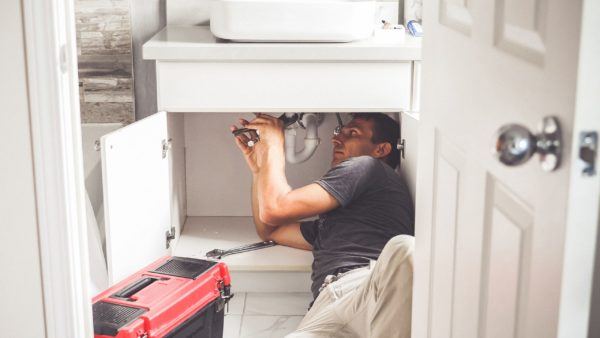
Where Is Your Main Shut-Off Valve?
When it comes to your water system, it is important to know where the main shut-off valve is for your particular system. Every system is slightly different, so it’s important to know what kind of system you have and be somewhat familiar with it to locate your main shut-off valve. If you are unsure about which valve is the main shut-off valve or if you’re having issues with your system, call your local plumbing company and they will be able to help with the repairs and show you where the valve is.
Why Is the Shut-Off Valve Important?
The main water shut-off valve controls the flow of water from the main water line into your home. Opening and closing this valve is an easy and effective way to completely shut off your home’s water supply. It’s important to know where the main line shut-off valve is in your home for a number of reasons. Also, knowing how to operate your main shut-off valve can save you a lot of money in repair bills if you experience issues such as plumbing leaks.
Every house is different though, and the main shut-off valve might not be in the same place in every home. Thankfully, there are a few key things to look for that can make finding your main shut-off valve a little easier.
Different Types of Systems and Locating Your Main Shut-Off Valve
When it comes to your main shut-off valve, it’s usually located in roughly the same area relative to your main water line. However, there is no standard location for the valve, so you may need to do some searching to find it. For your main water supply pipe, there are two places you would look to find the main shut-off valve. Typically, the main water shut-off is in the basement or crawl space. You’ll likely see a large pipe coming in from outside the house, a smaller pipe running up alongside it with the shut-off valve, and a water meter where the two pipes converge just past the shut-off valve. The valve itself is usually a few feet from where the main pipe comes in from outside.
If you have a sprinkler system, you may have a second shut-off valve connected to that system supplied from a different external water line. The sprinkler system may also have more than one valve. If this is the case, be sure to close the valve that is downstream from the sprinkler system.
If you can’t find the main shut-off valve inside your house, you should check outside near an outdoor faucet. Outdoor main shut-off valves are most common in warmer climates where freezing isn’t an issue, so most Wisconsin homeowners will have indoor valves. In some cases, the main shut-off valve is buried underground near the property line under a metal cover that might be labeled “water meter” or something similar to make it easier to identify.
What Does the Main Shut-Off Valve Look Like?
Knowing where to find the valve is half the battle, but you also need to know what the valves look like. Most shut-off valves will have one of two distinct appearances. The first is your classic “wheel” valve. This is the type of valve is in the shape of a wheel, and it’s typically what you’ll see on outdoor spigots. You’ll turn this valve clockwise to close it and counter-clockwise to open it. It usually takes around three to four turns to fully open or close the valve. The valve will stop once it’s fully opened or closed.
The other kind of shut-off valve is a lever valve. These are small flat levers that you can turn about 90 degrees to either be in line with the pipe or so that it is jutting out perpendicular to the pipe. The open position is running along the length of the pipe while the closed position is perpendicular to the pipe. Lever valves, which are more commonly used in newer main line shut-off valves, make it a lot easier to tell at a glance whether the valve is open or closed.
Valve Safety
Now that you know where to find your main water shut-off valve and how to operate it, there are a few things you can do to help make opening or closing your valve in an emergency easier. The first thing you’ll want to do is label your main shut-off valve with a hanging tag. This will make identifying the main shut-off valve a lot quicker and easier, as well as let others know what the valve does in case you need to send someone else to open or close it.
It’s also a good idea to keep a wrench near your valve just in case the valve starts to stick or won’t close easily. While rust normally isn’t an issue with valves, there are other things that can affect how smoothly a valve opens and closes, and a wrench or other tool might give you the leverage you need to get a stuck valve to close properly in a pinch.
Lastly, if you notice any issues with your main shut-off valve or any of the surrounding pipes, or any pipes in your home for that matter, don’t try to fix the problem yourself. There are different specifications of pipe used for different levels of water pressure or water volumes, and using the wrong kind of pipe could end up making more problems than it fixes. If you notice any problems with your pipes or valves, always call a professional to inspect the pipe in question and handle the repairs.
Reasons to Shut Off Your Water
There are a few reasons you might need to turn off your water at the main valve. The first and most obvious is if you are having repair work done and need to have the water off before your plumber begins work on an appliance or your general plumbing.
Another reason you might need to quickly shut off the main water supply is in the case of either a frozen or ruptured pipe. Frozen pipes can be a real threat in the winter, especially if you have pipes that are exposed to the elements or in uninsulated parts of your home. If you notice a sudden drop in water pressure to specific faucets on the same water line, shut off the main valve immediately since it might be a sign of a frozen pipe.
The last reason you might need to turn off the main water valve is if you’re preparing a summer home for the winter. You’ll want to shut off the water if you don’t plan on using the home for extended periods of time since stagnating water can freeze more quickly, and with no one in the house to catch it, you could end up coming back to ruptured pipes and a lot of costly repairs once the winter is over.
Fixing Your System
If you’re having problems with your water system or plumbing, the certified professionals at Black-Haak have you covered. Our plumbing team repairs, installs, and maintains plumbing systems throughout Fox Valley and the surrounding area. In addition to working on plumbing pipes, we provide drain cleaning, water heater, and water filtration services.
We also have a team of electricians who can help with all your electrical needs, including rewiring, panel replacement, and outlet and lighting installation. Need help with your heating or cooling system? We have a team of HVAC technicians ready to serve you. Give us a call at Black-Haak today for more information or to set up an appointment.

